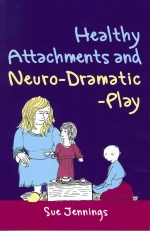 Dr Sue Jennings pioneered Dramatherapy and Playtherapy in the UK and Europe, and her career in professional theatre, play and dramatherapy, and social anthropology spans over 50 years. In 2002 she was awarded the Gertrud Schattner Plaque for ‘Excellence in Practice and Education in Drama Therapy’. Here, she answers some questions about her latest JKP book, Healthy Attachments and Neuro-Dramatic-Play.
Dr Sue Jennings pioneered Dramatherapy and Playtherapy in the UK and Europe, and her career in professional theatre, play and dramatherapy, and social anthropology spans over 50 years. In 2002 she was awarded the Gertrud Schattner Plaque for ‘Excellence in Practice and Education in Drama Therapy’. Here, she answers some questions about her latest JKP book, Healthy Attachments and Neuro-Dramatic-Play.
Tell us about your background and how you developed the theory of Neuro-Dramatic Play (NDP).
I come from a medical-theatrical family, so I suppose it is not surprising that I have been synthesising both in my pioneering work in Dramatherapy. Jessica published my very first book on the topic twenty years ago! However it is interesting the journey from Dramatherapy to Neuro-Dramatic-Play. I spent most of the ’70s and ’80s establishing training courses in the UK, Greece, Israel and beyond. During this time I was observing the developmental progression in young children that went through several stages that I then described as Embodiment-Progression-Role (EPR). I developed this as a methodology that could be integrated into Dramatherapy application and also any other therapies. EPR then grew into a form of assessment as well as therapeutic practice.
 Towards the end of the ’90s and subsequent years, I was working in fertility clinics and mother and baby units, in the UK and Romania, and observing toddlers in Kazakhstan. I felt that EPR was not detailed enough, it was in broad brush strokes that covered months and years. I was helped of course by all the new research in neuroscience and how we understand attachment in new ways. The impact of attachment on the development of the brain, is crucial in the early days and months; and of course we know far more now of the pre-development of the baby. The fact that babies are aware of the mothers’ moods and emotions, and they can recognise voices and music are just some of the things I was considering. Neuro-Dramatic-Play seemed appropriate because it includes the neuro from neuroscience, and the play which is essential for healthy attachment as well as the fact that babies interact ‘dramatically’ from hours of being born!
Towards the end of the ’90s and subsequent years, I was working in fertility clinics and mother and baby units, in the UK and Romania, and observing toddlers in Kazakhstan. I felt that EPR was not detailed enough, it was in broad brush strokes that covered months and years. I was helped of course by all the new research in neuroscience and how we understand attachment in new ways. The impact of attachment on the development of the brain, is crucial in the early days and months; and of course we know far more now of the pre-development of the baby. The fact that babies are aware of the mothers’ moods and emotions, and they can recognise voices and music are just some of the things I was considering. Neuro-Dramatic-Play seemed appropriate because it includes the neuro from neuroscience, and the play which is essential for healthy attachment as well as the fact that babies interact ‘dramatically’ from hours of being born!
In a nutshell, Neuro-Dramatic-Play is the core of attachment playfulness during pregnancy and the early months. It is very physical with massage, stroking and sensory play; it is very rhythmic with heartbeats, patting, rocking and singing; it is dramatic with echoing, imitation and interaction. Therefore it is sensory, rhythmic and dramatic playing between mothers and unborn-newborn infants.
How does NDP impact attachment, and what are some examples of NDP in practice?
NDP is attachment – you cannot have attachment without playfulness and the core of this early playfulness is NDP! For example when a mother is singing and rocking during pregnancy, that is rhythmic playing. When we apply NDP as a therapy then we have to find age appropriate activities that can mirror the lack of NDP in early development. With small children it is simpler as there is a lot of sensory play that they enjoy from bubbles to finger paint, and rocking and containing games. With teenagers even the bouncing of the ball one to another has a repetitive rhythmic quality; they are attracted to furry puppets and will model with clay and plasticine (the latter to my surprise!).
Is there something instinctual about NDP? Can it be practiced and learned?
Historically I think it was far more cultural (rather than instinctual) than it is now: babies were tied in a sling after birth and were constantly aware of the mother’s body and heartbeat; families and communities made music and sang together; there was support from the social group and community to their families. Nowadays you find many very lonely families and great pressures for mother to return to work so others are responsible for care in the early months and years. People seem to want small children to grow up very quickly, and crucial attachment stages are missed out. It is like the cocoon – if you hurry a butterfly’s struggle to be born, then it will be unable to fly as its wings will not have had the strengthening from the struggle! Maybe I need to write another book about this!
What is the relationship between play and the development of empathy?
We can only experience empathy if we have some idea of how other people feel and think – that infuriating phrase ‘I know where you are coming from’ (or ‘I know what you are saying!’), is supposed to indicate that we are talking to an empathic person! The exact opposite is true, as it is used when we are making complaints and the speaker is trying to appease us! True empathy is part of a very genuine understanding of the other person. And we learn this through dramatic playing which we can observe in the first few hours after a baby is born: they will try to imitate the expression on the mothers face. This is what we call the ‘as if’ or dramatic response – the baby is responding as if they are the mother; the dramatic response continues to develop in those early weeks and months, like a life rehearsal for the development of empathy.
Empathy is an important quality that is so often lacking in young children and teenagers; more often it is a capacity to ridicule other people, (influenced I am sure by television programmes and commercials).
How does attachment and NDP work differently for children on the autism spectrum and those with learning difficulties?
The only difference is that it takes longer! Often parents will give up and feel de-skilled rather than persist with the sensory, rhythmic and dramatic (interactive) playing. Stories are also very important in this process because they can contain all three sorts of playing.
In the book you pose the question: Is it too late for young people with attachment difficulties? How can NDP be adapted in these circumstances?
NDP together with EPR can be introduced at any stage – even with adults; much anti-social behaviour shows a craving for this early playful-attachment experience. We have NDP groups being undertaken in Romania and Israel with both children and adults, with participants making huge strides towards repairing the damage done by a lack of NDP in early life.
Copyright © Jessica Kingsley Publishers 2010.
Is crucial this attention to childdren need to play .